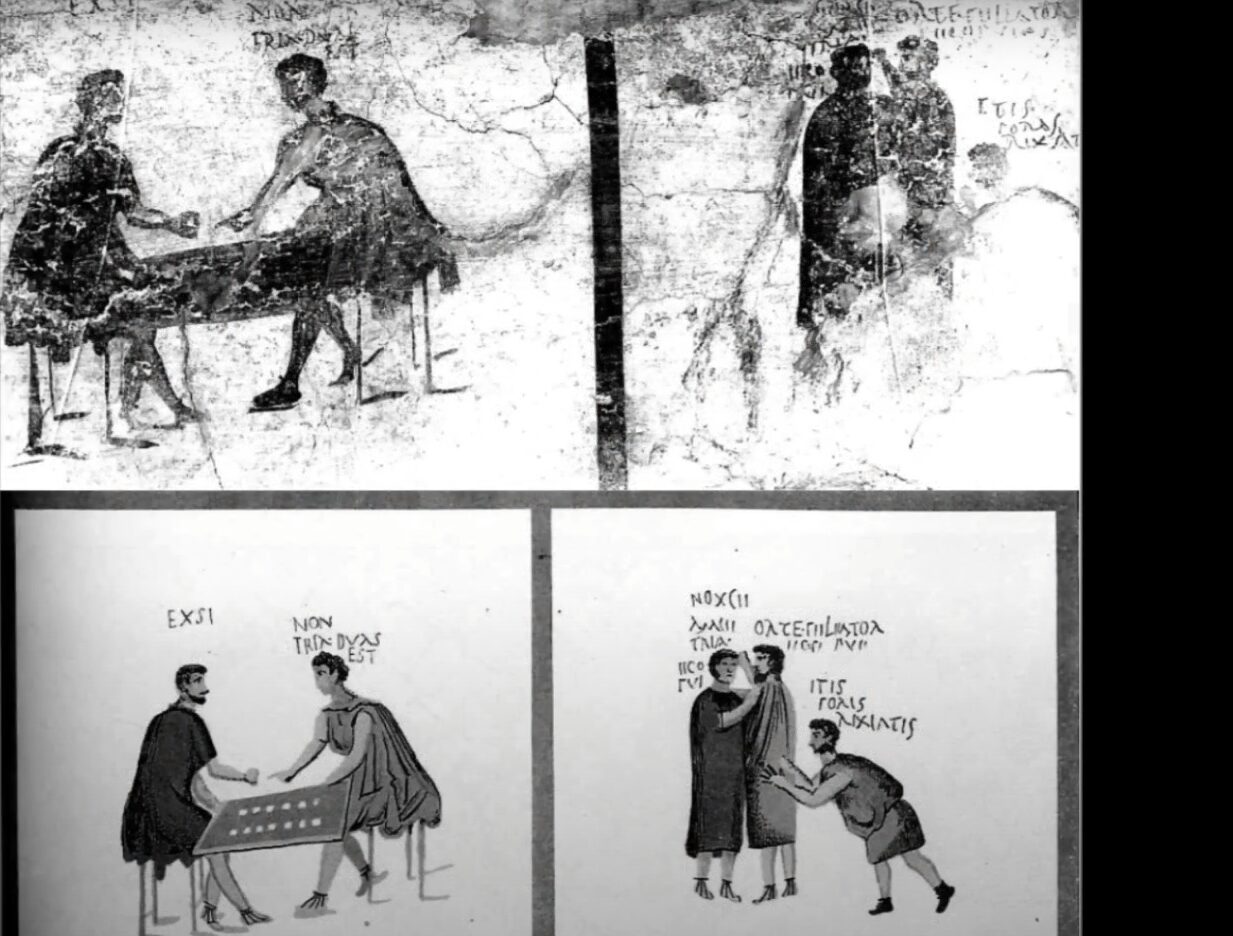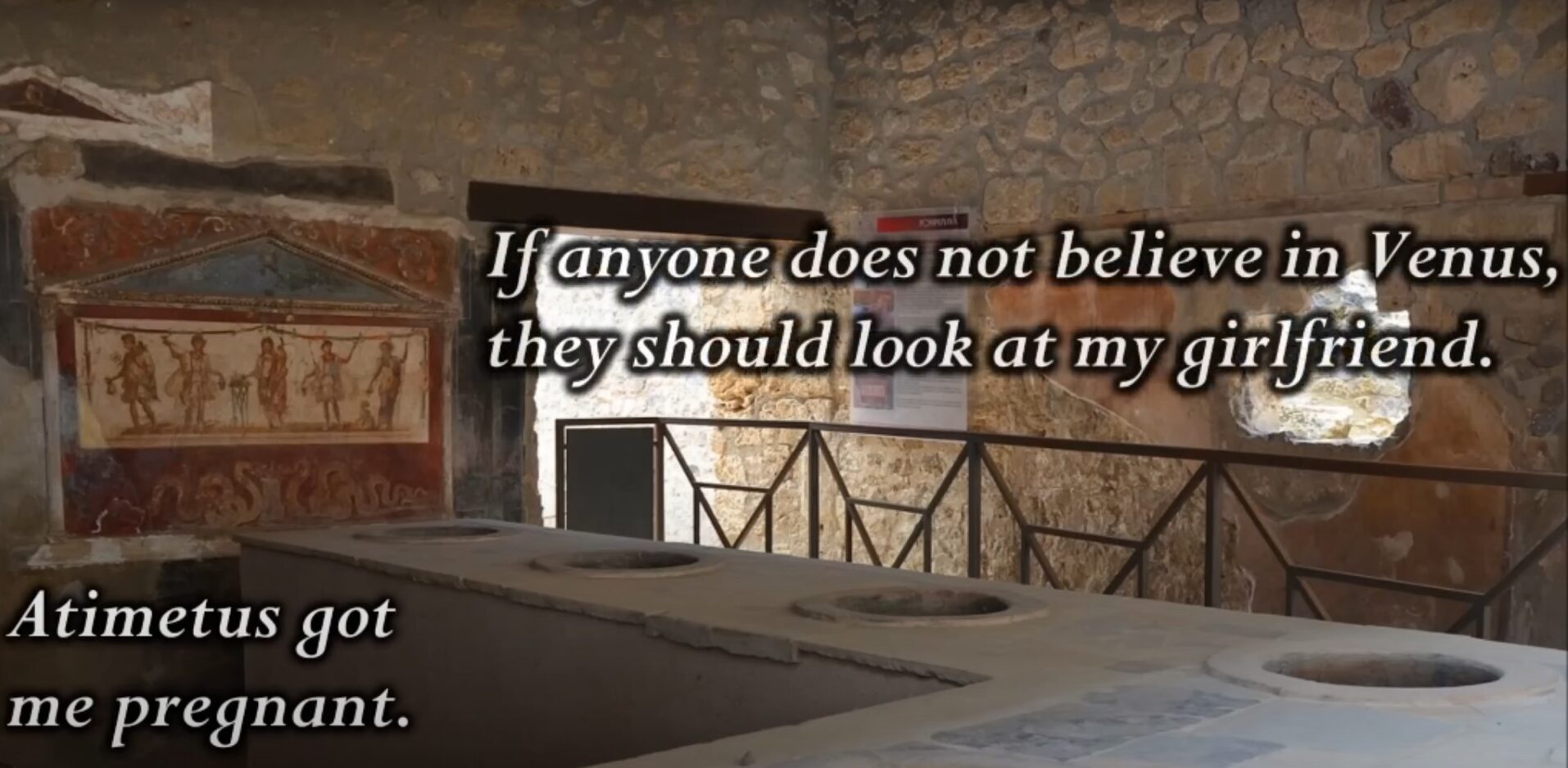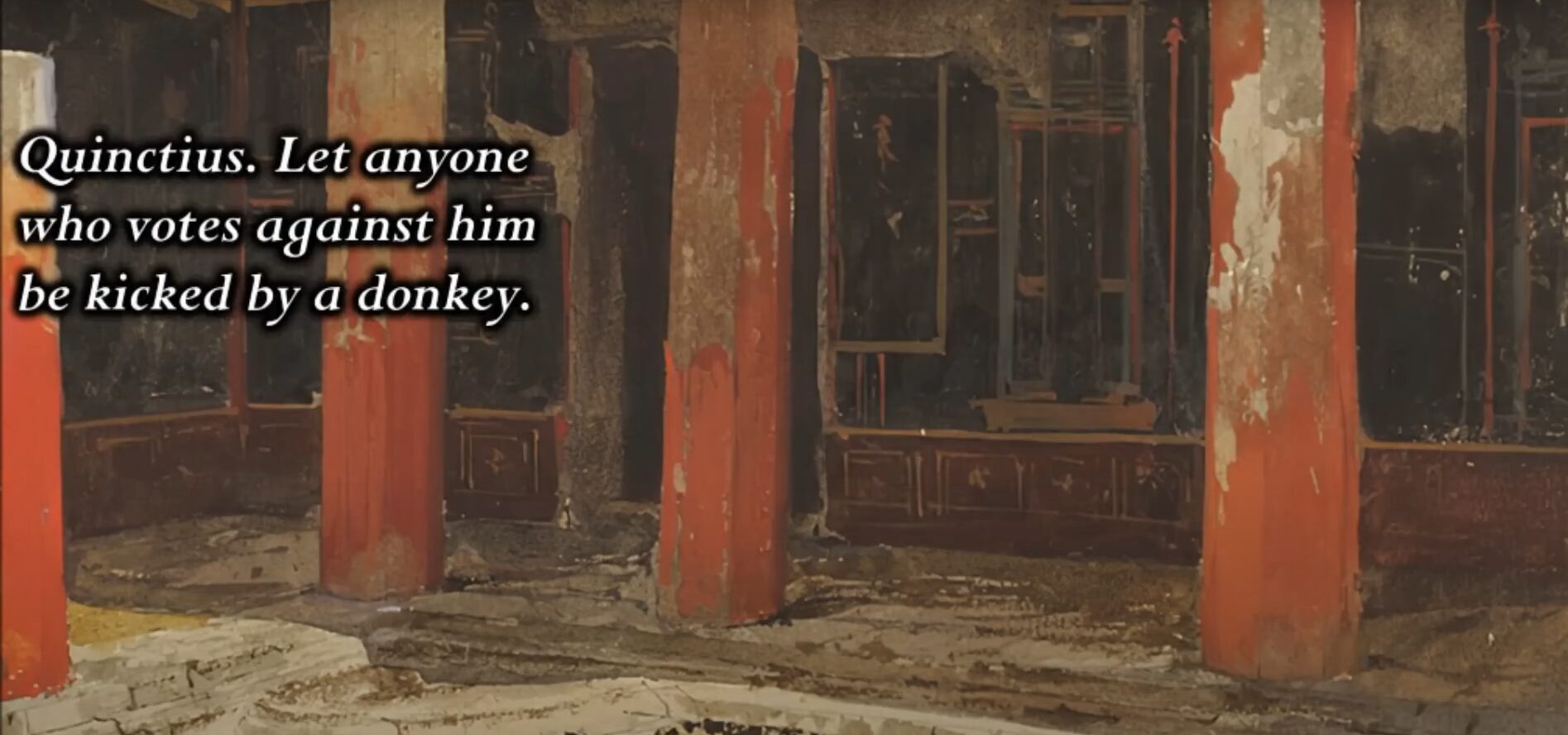Across the Roman world, people left their marks on walls, monuments, and public spaces. These writings and drawings captured moments of humor, love, anger, and daily life. They appeared in homes, taverns, and even sacred sites, offering a rare look at the voices of ordinary Romans rather than the elite. Many of these messages still survive, preserved by time and circumstance.
The graffiti of ancient Rome shows how people shared thoughts, jokes, and complaints long before modern communication. From Pompeii to distant provinces, these markings reveal what Romans valued and how they expressed themselves. They help modern readers understand the human side of history—one that speaks through casual words carved centuries ago.
Key Takeaways
- Ancient Roman graffiti reveals personal and social details of everyday life.
- The writings show how people communicated across cities and cultures.
- These markings preserve a human connection to the ancient world.
The Origins and Preservation of Roman Graffiti
Historical Background
Graffiti in the Roman world reflected daily life, humor, and personal expression. People wrote on walls to share thoughts, make jokes, confess love, or leave insults. The practice was not hidden or shameful; it was often accepted as part of public communication.
Romans used graffiti to record everyday experiences, from tavern arguments to love notes. Some messages praised gladiators or advertised events. Others complained about food, theft, or relationships. The writing styles ranged from crude to poetic, showing that both ordinary citizens and educated individuals took part.
| Common Themes | Examples of Content |
|---|---|
| Love and friendship | Declarations of affection, rivalries over lovers |
| Commerce and work | Ads for goods, missing items, or services |
| Humor and insults | Jokes, mockery, or playful warnings |
| Religion and politics | Appeals to gods, support for candidates |
Locations of Major Preservation
Pompeii holds the largest known collection of Roman graffiti, with over 11,000 examples. The volcanic eruption of 79 CE sealed the city in ash, preserving walls, buildings, and even latrines covered in inscriptions. The graffiti appear in homes, inns, and public spaces, showing how common the practice was.
In gladiator barracks, writers recorded fights, boasts, and personal notes. In taverns, they left jokes and arguments scratched into plaster. Some drawings depict simple scenes like gambling or daily chores, while others show more detailed images.
Beyond Italy, Egypt’s pyramids also contain graffiti left by Roman and Greek visitors. These travelers carved their names, short poems, or opinions about what they saw. Some even debated with earlier writers, leaving replies beneath their messages.
These preserved writings reveal that graffiti served as a form of ancient social interaction—a way for people to speak to others across time, leaving behind traces of their thoughts and humor on the walls of their world.
Graffiti in Pompeii
Daily Life and Social Messages
Over 11,000 pieces of writing remain on the walls of Pompeii. These short notes reveal what people did and thought each day. Inns, taverns, and homes carried messages about food, friends, and even small mistakes. Some wrote about their jobs or left personal remarks like “I made bread” or “We two dear men were here.”
A few inscriptions show how people used graffiti to communicate directly. For example, one message warned others about missing items and offered rewards for their return. Others left advice, greetings, or jokes that reflected the casual tone of daily Roman life.
Affection, Jokes, and Rivalries
Love and humor appeared often on the city’s walls. Many wrote about their crushes or romantic troubles. Some shared playful insults or boasts, while others recorded arguments between rivals. A well-known exchange between two men competing for the same woman shows how public these feelings could be.
Romans also wrote witty remarks and bathroom jokes, proving that humor crossed all social classes. These writings often mixed affection and teasing, showing both the warmth and tension of relationships in Pompeii.
Complaints, Notices, and Public Posts
Graffiti often served as a public message board. People used walls to complain about poor service, promote events, or make announcements. In the gladiator barracks, one writer recorded upcoming fights with names and dates. Others wrote political endorsements or warnings, showing that graffiti could act as informal advertising.
Below is a simple look at the types of messages found:
| Type of Message | Example Purpose |
|---|---|
| Complaint | “This food is poison” |
| Event Notice | “Felix will fight the bears” |
| Personal Ad | “Antiochus hung out here with his girlfriend” |
| Political Support | “Vote for Numerus Barka” |
These writings gave citizens a way to share opinions and news without official permission.
Sketches and Visual Creativity
Not all graffiti were words. Many people drew small pictures, from childlike doodles to detailed scenes. Some showed gamblers arguing, others depicted fights or daily work. Artists even restored damaged drawings to preserve the original images.
Walls also featured symbols, gods, and animals, suggesting that drawing was another way to express thought or identity. Even when crude, these sketches reveal that art was part of ordinary life and open to anyone with something to say.
Themes and Content of Roman Graffiti
Personal Notes and Declarations
Roman graffiti often captured the daily lives and emotions of ordinary people. Many wrote short messages like “So-and-so was here” or “I love this person.” Others confessed personal matters, such as love affairs, jealousy, or even pranks.
Common subjects included:
- Romantic confessions and heartbreak
- Friendship statements (“We two dear men, friends forever”)
- Everyday updates, such as baking bread or attending games
These writings show how Romans used walls to record feelings and experiences much like people post online today.
Political and Business Notices
Walls also served as public noticeboards. Candidates for office or their supporters painted slogans asking for votes. Shopkeepers and craftsmen used graffiti to promote goods or services.
| Type | Example Purpose |
|---|---|
| Political | Support for local candidates or officials |
| Commercial | Advertising food, drink, or products |
| Practical | Reporting lost or stolen items |
Such messages blended politics, commerce, and community life, showing how open communication was part of Roman urban culture.
Taunts, Jokes, and Crude Remarks
Humor and insults appeared everywhere, from taverns to public toilets. Some mocked friends, rivals, or strangers. Others joked about bodily functions or left sarcastic remarks about love and luck.
Examples included:
- Insults about appearance or behavior
- Mock rivalries between lovers or gladiators
- Toilet humor repeated for emphasis
These scribbles reveal a culture that accepted playful, rude, and even vulgar expression as part of public life.
Graffiti Beyond Pompeii: The Roman World
Inscriptions on the Egyptian Pyramids
Ancient travelers from Greece and Rome carved their names and short notes on the pyramids of Egypt. Many wrote simple phrases like “I was here” or “I saw and admired.” Others added longer verses or comments about their visit.
Some of these writings even read like short arguments. One visitor complained that he disliked everything except the sarcophagus, while another mocked him for caring about the hieroglyphs. Locals may have accepted or even encouraged these markings as part of the tourist experience.
| Example Message | Tone |
|---|---|
| “I visited and did not like anything except the sarcophagus.” | Critical |
| “Why do you care that you cannot read the hieroglyphics?” | Sarcastic |
Travel and Visitors in the Ancient World
Roman tourists often traveled across the empire, leaving graffiti wherever they went. These inscriptions acted like travel logs, showing who visited, what they saw, and what they thought.
They recorded names, professions, and hometowns, creating a record of movement across regions. The graffiti turned monuments and temples into public guestbooks where visitors left proof of their journeys.
Common Purposes of Ancient Graffiti:
- To mark a visit or express admiration
- To share opinions or jokes
- To record personal names and origins
Views on Writing on Walls
Graffiti in the Roman world was not always seen as vandalism. People used walls as a space for humor, love notes, political messages, and everyday conversation. Writing on buildings was often tolerated, especially in busy public areas.
In cities like Pompeii, even respected citizens left their marks. The act of writing on walls served as a form of open communication rather than destruction. These markings show that Romans viewed graffiti as a normal, sometimes even valued, part of daily life.
Social Functions of Roman Graffiti:
- Shared messages and announcements
- Displayed wit or emotion
- Reflected community interaction and literacy
Social Significance and Modern Insights
Early Forms of Public Expression and Conversation
Graffiti in ancient cities acted much like public message boards. People used walls to share jokes, complaints, love notes, and political opinions. These writings turned streets, taverns, and even latrines into spaces for open conversation.
| Type of Message | Example Purpose |
|---|---|
| Personal | Declare affection or friendship |
| Commercial | Advertise goods or services |
| Political | Endorse or criticize local figures |
| Humorous | Share insults, jokes, or wordplay |
This practice shows that communication in public spaces was not limited to the elite. Ordinary citizens used walls to speak to their community directly.
Reading, Writing, and Everyday Communication
The graffiti reveal much about who could read and write. Some messages contain spelling errors or simple phrasing, suggesting that literacy reached beyond scholars. People used everyday language, not formal Latin, to express themselves.
- Signatures show pride in identity.
- Errors show how people actually spoke.
- Short notes reflect daily concerns like love, loss, and money.
These markings provide a record of voices often missing from official history. They represent how common people interacted with written language in informal, personal ways.
The graffiti make ancient people feel familiar and real. Their humor, frustration, and affection mirror modern emotions. A wall covered in jokes and confessions reminds readers that humans have always wanted to be heard.
Even centuries later, the words still connect people across time. They show that communication, whether scratched on stone or typed online, serves the same purpose—to share experiences and leave a trace of one’s life.
Legacy of Roman Graffiti
Lasting Influence on How History Is Understood
Roman graffiti gives historians direct evidence of how ordinary people lived. Unlike official records, these markings show what people thought, joked about, and argued over. They include love notes, insults, political messages, and simple statements like “I was here.”
Archaeologists use these writings to study literacy, language, and social behavior. For example:
| Type of Graffiti | What It Reveals |
|---|---|
| Love messages | Personal emotions and relationships |
| Complaints about food or service | Attitudes toward daily life |
| Political slogans | Local opinions and civic involvement |
| Drawings and jokes | Humor and leisure activities |
These details help build a clearer picture of Roman society beyond the view of elites.
Traces of Everyday Lives
Graffiti shows that Romans wanted to be remembered, even in small ways. Messages carved into walls, taverns, and monuments speak of friendship, rivalry, and humor. Some writers bragged, others mourned, and many simply marked their presence.
This writing style feels familiar today because it mirrors how people post comments or notes online. Through these brief messages, modern readers can sense the voices of those who lived centuries ago—ordinary citizens leaving behind traces of their thoughts and feelings.



